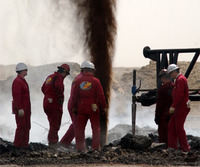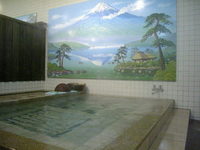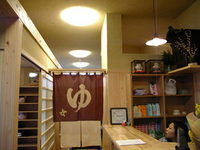飛騨の銭湯について
昨日、疲れたので、近くの銭湯に行きましたら、こんな掲示板がありました。

なんと、「湯ーとぴあ」さんで、1996年にアメリカのワシントンポスト紙に掲載されたとの事。
こんな記事が書かれています。
「Keeping Bathhouses Afloat
Japanese Turn Trendy to Preserve the Tradition
---------------------------------------------
By Kevin Sullivan and Mary Jordan
Washington Post Foreign Services
---------------------------------------------
TAKAYAMA,Japan---For 40 years, the public bathhouse run by three generations of
Nakamura fami-ly was a quiet neighboehood tub known as Inari Yu, a traditional
name honoring the fox god of Shintoism.
Today it is "Utopia!" Outside it's painted pink and skylights, a Jacuzzi and a sauna,
blow-dryres and even the Japanese rarity of a diaperchanging table in the men's
locker room.
"We weren't meeting the needs of our customers; just having hot water and a wash
is not enough anymore,"said Itsuro Nakamura, standing near dis-play of fancy
imported shampoos and conditioners in his bright lobby.
For Nakamura,44,this is Dawinism of the '90s,survival of the trendiest.
Japanese public baths, or sentos,one of this nation's most prized culturarl pheno-
mena,have been disapearing for years. There were 23,000 public baths in Japan at
their peak in the mid-1960s, when more See BATHS,B4,Col.1

than 6 million people a day visited the baths in Tokyo alone. But the numbet of
sentos has shrunk to an all-time low of just over 10,000, and only about 275,000
people in Tokyo go each day.
More and more homes here have bathtubs, and new generations of younger Japan-
ese find the notion of bathing maked with their neighbors a quaint but outdated
tradition.
To survive dwindling use and rising costs,the remaining public baths are turning to
gimmicks and yuppie comforts. Where once there were only hotwater taps for wash-
ing and a big communal tub for soeking afterward, now there are coffee bars and
baths sprinkled with wine.There are washers and dryers and massage chairs and
catchy slogans,often in English,which is considered modern and hip. The sign at
Utopia! says,"A hot bath is a great refreshment after a day's work!"

The Akua Sento in Tokyo was renovated three years ago to bring back lost customers,
Management added a sauna, a small swimming pool and an outdoor bath that offers
a variety of waters,including a Chinese medicinal herb bath one day, a bath of "forest"
herbs another day and a wine bath on Saturdays.
"For our businesses to survive, we were compelled to thing about what we could offer
that our customers didn't have at home",said the National Associa-tion of Public Baths.
Public bathhouses have existed in Japan since the 8th century, when they were central
features of Buddist temples.Over the centuries, they have served the same purpose as
the pubs of Ireland,the cafes of Paris and the general stores of New England.They are
meeting places where neighbors swap news and gossip and a sense of community is
cemented--all in the buff, in Japan's case.
They have been practical places for other reasons, too.Indoor plumbling arrived late in
Japan, which didn't open itself to trade with the outside world until the mid-19th century.
More than 40 percent of Japanese still live in homes without flush toilets,although about
94 percent of Japanese homes now have bathtubs.But those tubs are often tiny,with no
room to stratch arms and legs,and not nearly as steamy as the public bathhouse.
At Japanese sentos, which charge about $3 to $8,bathers sit in front of small spigots
and fully wash themselves with soap and shampoo. Only after they wash and rinse off
do they immerse themselves in the large communal tub, which can usually accommodate
10 to 15 people.There they have a long soak in water usually kept at 105 to 108 degrees,
which even in Tokyo often bubbles up from natural hot springs.
In many places in the world, public bathhouses are associated with sex, Certain Japanese
baths do offer what is euphemistically called "massage,"but the tra-ditional sentos are family
establishments.
Sentos have been renovated like mad in recent years.Saunas and Jacuzzis came first, but
lately the amenities are getting slicker.The old YMCA locker room feel is giving way to the
atmosphere of a fancy health club. Masayoshi Hosokawa, owner of Tatsu No Yu,or "Dragon's
Bath,"in Tokyo has added a 32-seat restaurant that looks like a small banquet hall.There is a
separate room for karaoke,stage included.Behind the stage is a mural of Yoshiiku Utagawa's
famous painting"Quarreling & Scuffling in the Women's Bathhouse."The place is outfitted with
a piano, and is used for small recitals.A few years ago it was the setting for parts of a movie
called "Doku Doku (Poison)Monster 2." In another area, there are baths in a small enclosed
porch area with skylights that open in warm weather.With murals of mountains on all four walls,
the baths give the effect of one of Japan's outdoor onsen, or hot springs.
"We have things now that I had never heard of before,"said Hosokawa, who has been in the
sento business for most of his 80-plus years.
Like many of the renovated sentos, Utopia! in Takayama,a beautiful valley town high in the
mountains of central Japan, seems to be holding its own against the odds. As Nakamura
spoke in the sento lobby, dozens of customers came in and disappeared into the men's
and women's baths, marked with blue and pink signs that said "Lords"and"Princesses."
Nakamura said most of his customers come for the sur-roundings, even if the have baths
at home;"Why do people go to a coffee shop when they can have coffee at home,"he said,
"People go to enjoy the atmosphere, to relax and talk with other people."
Three generations of Nakamura still work at the shop:Nakamura and his wife, his 70-year-old
mother and his16-year-old daughter.Nakamura said business is getting better, and he credits
much of the success to his ability to keep up with changing times.
Utopia! is a play on the Japanese word yu, which means hot water.Nakamura said that when
he was choosing a new name, he liked the pun,but he liked the English word even more.
"If my new sento had the image of utopia,"he said."it would be wonderful."」
翻訳すると下記の通りです。
「浴場を破綻させないこと
伝統を維持するために流行の日本のやり方
-
ケヴィンサリバンとメアリージョーダンより
ワシントンポスト外地勤務
-
日本の高山 ― 40年間、公共お風呂屋さんは、中村家の3世代によって経営され、
静かな御近所さんたちに、稲荷湯(神道のキツネ神を礼拝している伝統的な名前)
として知られていました。
今日、それは「ユートピア」と言う名前です!それがピンクと天窓を塗った外観、
ジャグジーとサウナ(乾燥サウナと男子ロッカールームが兼備している状態の日本
でも稀なものです)。
「私たちは、常連のお客さんの要望を満たしていませんでした。ちょうどお風呂と体を洗う
ことだけではもう十分でありません 」― (店主)中村逸郎はいった ― 彼は輸入シャンプー
とコンディショナーのディスプレイの近くの明るいロビーで立ちながら話しました。
中村さん(44歳),これは90年代の最も流行のものの生き残りるための進化論です。
日本の公衆浴場、あるいは、この国の最も重んじられた文化的空間の銭湯は消えていきます。
最盛期には23,000の公衆浴場が、ピークの時日本にありました-それは1960年代でした。 (BATHS,B4,Col.1を見てください)
最大時、一日600万人の人が東京で銭湯に行きました。しかし、銭湯の数はちょうど10,000以下に
なり、最低記録なりました、そして、東京では約275,000人が毎日行っています。
この国では多くの家がお風呂を持っています、そして、より若い日本人の新世代は入浴する考え
が彼らの隣人と変わり、銭湯は面白いが時代遅れの伝統だと言っています。
減少をくいとめるために、いままでのお湯が出る蛇口と、洗浄場、ドライヤーとマッサージの
ついた公衆浴場のままになっている場所は、新しい仕掛けと若い人が快適に感じる場所へと変わって
きています。
その一つが喫茶店がある、そして、ワインを飲みながら語れるような場所があります。
ユートピアの看板は語っています!一日のお仕事の後に、あったかい温泉がくつろげます!」
東京のアクアセントウは減った顧客を取り戻すために3年前に刷新されました、経営者はサウナや
小さな泳げるプールや、漢方薬の温泉をある日はやって、森林浴の温泉を他の日にやったり、
土曜日にはワイン風呂をやったりしています。
「生き残るために、私たちはお客様が家では味わえない、出来るだけの事を提供することが大事だ」
と組合長は言いました。
公衆浴場はお寺が広まるようになった8世紀から日本に存在しました。佛教はアイルランドのパブや
パリの喫茶店やイギリスの雑貨店と同じ目的のことを提供しました。それは隣人がニュースを交換する
場やゴシップで、そこで共同体意識は結合されるというものでした。 ―ほとんどの黄色人種で。これは
日本のケースですが。
彼らは、他の理由の実際的な場所でもありました。屋内配管は、日本に取り付けられるようになった
のはだいぶ跡の事で、19世紀中頃までは外部に開かれることはありませんでした。日本人は94%の
家庭がお風呂を持っていますが、40パーセント以上の日本人水洗式トイレなしです。
しかしこういったお風呂場は時には狭く感じ、足や腕を伸ばすことも出来ませんし、お風呂屋さんほど
十分な蒸気があるわけではありません。
銭湯は大体$3から$8くらいの値段ですが、そこで体を洗う人は小さな栓の前に座って、石鹸と
シャンプーで完全に彼ら自身を洗います。
体を洗ったりリンスをつけたりしないときだけ、日本人は大きな浴槽に自分の体を浸します。それは
だいたい10人から15人くらいの人が浸かることが出来ます。それは華氏105~108度(摂氏38から42度)
で、東京でさえそれは、自然の温泉をくみ上げられています。
世界の多くの場所では、公衆浴場とはセックスと関係しています。確かに日本の公衆浴場では
「マッサージ」と婉曲的に呼ばれていますが、伝統的な銭湯は、家族によって運営されています。
銭湯は、近年狂ったように刷新されました。サウナとジャグジーが最初に登場しました、しかし、
最近、アメニティが起ってきています。古いYMCAロッカールームが装飾的なヘルスクラブの雰囲気
に変わってきています。
細川正義、東京の「辰の湯」あるいは「ドラゴンバス」の所有者は、小さな宴会ホールのような
32-席レストランを加えました。そこにはカラオケの部屋もあり、ステージと一緒になった別の場所も
あります。
ステージの後ろのところにはは歌川よしいくの有名な壁画が女性用の浴室にあります。
そこにはがピアノが装備していて、小さなリサイタルにも使われます。
数年前、そこでは「ドクドク(毒)モンスター 2」といわれた映画のセットでした。
別の場所には、暖かい天気の中で天窓が開く小さな区切られた浴室があります。
全4枚の山の壁画の壁があり、浴室は日本の露天風呂または温泉のような雰囲気を与えます。
「私たちは、今まで聞いたことないようなものを提供しています」と、80年以上もこの商売を
やってきた細川さんが言いました。
日本の真ん中の山に囲まれた谷あいの美しい町高山にある「ゆうとぴあ」のように、刷新されたほとんど
の銭湯のように、それまでのものに対して新しいものを持っているようです。
中村さんと銭湯のロビーで話しているときに、何十人のお客さんは、店に来て男性用と女性用の方へ
消えていきました。そしてそこには、「殿」と「姫」と書かれている青くとピンクの印という特徴が
ありました。
中村さんが言うには「大部分のうちのお客さんは近所の人です。家にお風呂がある人でも来ます。
「どうして彼らが自宅でコーヒーを飲むことができるのに、人々は喫茶店に行くでしょうか」、
彼は言いました、「人々は雰囲気を楽しみに行きます。そして、リラックスして他の人と話すんです。」
中村さん家のの3世代は、まだ店で働いています。中村さんと彼の妻、彼の70才の母と彼の16才の娘さん
です。
中村さんは商売が上向きであると言いました、そして、彼は時を変えることが成功秘訣であると思うと
語りました。
ゆうとぴあ! お湯を意味する「ゆ」の日本語の遊びです。
彼が新しい名前を選んでいたとき、彼は英単語の言葉「ブレッド」より「パン」が好きでした。
「私の新しい銭湯にはユートピアのイメージがあるならば、それは素晴らしいです。」と彼は言いました。
(久しぶりに英訳しました。ちゃんとあっていないかもしれません)
こんな記事を見つけたので、高山の減り行く銭湯について番組で話したいと思います。
2月の予定です。
徳積善太
なんと、「湯ーとぴあ」さんで、1996年にアメリカのワシントンポスト紙に掲載されたとの事。
こんな記事が書かれています。
「Keeping Bathhouses Afloat
Japanese Turn Trendy to Preserve the Tradition
---------------------------------------------
By Kevin Sullivan and Mary Jordan
Washington Post Foreign Services
---------------------------------------------
TAKAYAMA,Japan---For 40 years, the public bathhouse run by three generations of
Nakamura fami-ly was a quiet neighboehood tub known as Inari Yu, a traditional
name honoring the fox god of Shintoism.
Today it is "Utopia!" Outside it's painted pink and skylights, a Jacuzzi and a sauna,
blow-dryres and even the Japanese rarity of a diaperchanging table in the men's
locker room.
"We weren't meeting the needs of our customers; just having hot water and a wash
is not enough anymore,"said Itsuro Nakamura, standing near dis-play of fancy
imported shampoos and conditioners in his bright lobby.
For Nakamura,44,this is Dawinism of the '90s,survival of the trendiest.
Japanese public baths, or sentos,one of this nation's most prized culturarl pheno-
mena,have been disapearing for years. There were 23,000 public baths in Japan at
their peak in the mid-1960s, when more See BATHS,B4,Col.1
than 6 million people a day visited the baths in Tokyo alone. But the numbet of
sentos has shrunk to an all-time low of just over 10,000, and only about 275,000
people in Tokyo go each day.
More and more homes here have bathtubs, and new generations of younger Japan-
ese find the notion of bathing maked with their neighbors a quaint but outdated
tradition.
To survive dwindling use and rising costs,the remaining public baths are turning to
gimmicks and yuppie comforts. Where once there were only hotwater taps for wash-
ing and a big communal tub for soeking afterward, now there are coffee bars and
baths sprinkled with wine.There are washers and dryers and massage chairs and
catchy slogans,often in English,which is considered modern and hip. The sign at
Utopia! says,"A hot bath is a great refreshment after a day's work!"
The Akua Sento in Tokyo was renovated three years ago to bring back lost customers,
Management added a sauna, a small swimming pool and an outdoor bath that offers
a variety of waters,including a Chinese medicinal herb bath one day, a bath of "forest"
herbs another day and a wine bath on Saturdays.
"For our businesses to survive, we were compelled to thing about what we could offer
that our customers didn't have at home",said the National Associa-tion of Public Baths.
Public bathhouses have existed in Japan since the 8th century, when they were central
features of Buddist temples.Over the centuries, they have served the same purpose as
the pubs of Ireland,the cafes of Paris and the general stores of New England.They are
meeting places where neighbors swap news and gossip and a sense of community is
cemented--all in the buff, in Japan's case.
They have been practical places for other reasons, too.Indoor plumbling arrived late in
Japan, which didn't open itself to trade with the outside world until the mid-19th century.
More than 40 percent of Japanese still live in homes without flush toilets,although about
94 percent of Japanese homes now have bathtubs.But those tubs are often tiny,with no
room to stratch arms and legs,and not nearly as steamy as the public bathhouse.
At Japanese sentos, which charge about $3 to $8,bathers sit in front of small spigots
and fully wash themselves with soap and shampoo. Only after they wash and rinse off
do they immerse themselves in the large communal tub, which can usually accommodate
10 to 15 people.There they have a long soak in water usually kept at 105 to 108 degrees,
which even in Tokyo often bubbles up from natural hot springs.
In many places in the world, public bathhouses are associated with sex, Certain Japanese
baths do offer what is euphemistically called "massage,"but the tra-ditional sentos are family
establishments.
Sentos have been renovated like mad in recent years.Saunas and Jacuzzis came first, but
lately the amenities are getting slicker.The old YMCA locker room feel is giving way to the
atmosphere of a fancy health club. Masayoshi Hosokawa, owner of Tatsu No Yu,or "Dragon's
Bath,"in Tokyo has added a 32-seat restaurant that looks like a small banquet hall.There is a
separate room for karaoke,stage included.Behind the stage is a mural of Yoshiiku Utagawa's
famous painting"Quarreling & Scuffling in the Women's Bathhouse."The place is outfitted with
a piano, and is used for small recitals.A few years ago it was the setting for parts of a movie
called "Doku Doku (Poison)Monster 2." In another area, there are baths in a small enclosed
porch area with skylights that open in warm weather.With murals of mountains on all four walls,
the baths give the effect of one of Japan's outdoor onsen, or hot springs.
"We have things now that I had never heard of before,"said Hosokawa, who has been in the
sento business for most of his 80-plus years.
Like many of the renovated sentos, Utopia! in Takayama,a beautiful valley town high in the
mountains of central Japan, seems to be holding its own against the odds. As Nakamura
spoke in the sento lobby, dozens of customers came in and disappeared into the men's
and women's baths, marked with blue and pink signs that said "Lords"and"Princesses."
Nakamura said most of his customers come for the sur-roundings, even if the have baths
at home;"Why do people go to a coffee shop when they can have coffee at home,"he said,
"People go to enjoy the atmosphere, to relax and talk with other people."
Three generations of Nakamura still work at the shop:Nakamura and his wife, his 70-year-old
mother and his16-year-old daughter.Nakamura said business is getting better, and he credits
much of the success to his ability to keep up with changing times.
Utopia! is a play on the Japanese word yu, which means hot water.Nakamura said that when
he was choosing a new name, he liked the pun,but he liked the English word even more.
"If my new sento had the image of utopia,"he said."it would be wonderful."」
翻訳すると下記の通りです。
「浴場を破綻させないこと
伝統を維持するために流行の日本のやり方
-
ケヴィンサリバンとメアリージョーダンより
ワシントンポスト外地勤務
-
日本の高山 ― 40年間、公共お風呂屋さんは、中村家の3世代によって経営され、
静かな御近所さんたちに、稲荷湯(神道のキツネ神を礼拝している伝統的な名前)
として知られていました。
今日、それは「ユートピア」と言う名前です!それがピンクと天窓を塗った外観、
ジャグジーとサウナ(乾燥サウナと男子ロッカールームが兼備している状態の日本
でも稀なものです)。
「私たちは、常連のお客さんの要望を満たしていませんでした。ちょうどお風呂と体を洗う
ことだけではもう十分でありません 」― (店主)中村逸郎はいった ― 彼は輸入シャンプー
とコンディショナーのディスプレイの近くの明るいロビーで立ちながら話しました。
中村さん(44歳),これは90年代の最も流行のものの生き残りるための進化論です。
日本の公衆浴場、あるいは、この国の最も重んじられた文化的空間の銭湯は消えていきます。
最盛期には23,000の公衆浴場が、ピークの時日本にありました-それは1960年代でした。 (BATHS,B4,Col.1を見てください)
最大時、一日600万人の人が東京で銭湯に行きました。しかし、銭湯の数はちょうど10,000以下に
なり、最低記録なりました、そして、東京では約275,000人が毎日行っています。
この国では多くの家がお風呂を持っています、そして、より若い日本人の新世代は入浴する考え
が彼らの隣人と変わり、銭湯は面白いが時代遅れの伝統だと言っています。
減少をくいとめるために、いままでのお湯が出る蛇口と、洗浄場、ドライヤーとマッサージの
ついた公衆浴場のままになっている場所は、新しい仕掛けと若い人が快適に感じる場所へと変わって
きています。
その一つが喫茶店がある、そして、ワインを飲みながら語れるような場所があります。
ユートピアの看板は語っています!一日のお仕事の後に、あったかい温泉がくつろげます!」
東京のアクアセントウは減った顧客を取り戻すために3年前に刷新されました、経営者はサウナや
小さな泳げるプールや、漢方薬の温泉をある日はやって、森林浴の温泉を他の日にやったり、
土曜日にはワイン風呂をやったりしています。
「生き残るために、私たちはお客様が家では味わえない、出来るだけの事を提供することが大事だ」
と組合長は言いました。
公衆浴場はお寺が広まるようになった8世紀から日本に存在しました。佛教はアイルランドのパブや
パリの喫茶店やイギリスの雑貨店と同じ目的のことを提供しました。それは隣人がニュースを交換する
場やゴシップで、そこで共同体意識は結合されるというものでした。 ―ほとんどの黄色人種で。これは
日本のケースですが。
彼らは、他の理由の実際的な場所でもありました。屋内配管は、日本に取り付けられるようになった
のはだいぶ跡の事で、19世紀中頃までは外部に開かれることはありませんでした。日本人は94%の
家庭がお風呂を持っていますが、40パーセント以上の日本人水洗式トイレなしです。
しかしこういったお風呂場は時には狭く感じ、足や腕を伸ばすことも出来ませんし、お風呂屋さんほど
十分な蒸気があるわけではありません。
銭湯は大体$3から$8くらいの値段ですが、そこで体を洗う人は小さな栓の前に座って、石鹸と
シャンプーで完全に彼ら自身を洗います。
体を洗ったりリンスをつけたりしないときだけ、日本人は大きな浴槽に自分の体を浸します。それは
だいたい10人から15人くらいの人が浸かることが出来ます。それは華氏105~108度(摂氏38から42度)
で、東京でさえそれは、自然の温泉をくみ上げられています。
世界の多くの場所では、公衆浴場とはセックスと関係しています。確かに日本の公衆浴場では
「マッサージ」と婉曲的に呼ばれていますが、伝統的な銭湯は、家族によって運営されています。
銭湯は、近年狂ったように刷新されました。サウナとジャグジーが最初に登場しました、しかし、
最近、アメニティが起ってきています。古いYMCAロッカールームが装飾的なヘルスクラブの雰囲気
に変わってきています。
細川正義、東京の「辰の湯」あるいは「ドラゴンバス」の所有者は、小さな宴会ホールのような
32-席レストランを加えました。そこにはカラオケの部屋もあり、ステージと一緒になった別の場所も
あります。
ステージの後ろのところにはは歌川よしいくの有名な壁画が女性用の浴室にあります。
そこにはがピアノが装備していて、小さなリサイタルにも使われます。
数年前、そこでは「ドクドク(毒)モンスター 2」といわれた映画のセットでした。
別の場所には、暖かい天気の中で天窓が開く小さな区切られた浴室があります。
全4枚の山の壁画の壁があり、浴室は日本の露天風呂または温泉のような雰囲気を与えます。
「私たちは、今まで聞いたことないようなものを提供しています」と、80年以上もこの商売を
やってきた細川さんが言いました。
日本の真ん中の山に囲まれた谷あいの美しい町高山にある「ゆうとぴあ」のように、刷新されたほとんど
の銭湯のように、それまでのものに対して新しいものを持っているようです。
中村さんと銭湯のロビーで話しているときに、何十人のお客さんは、店に来て男性用と女性用の方へ
消えていきました。そしてそこには、「殿」と「姫」と書かれている青くとピンクの印という特徴が
ありました。
中村さんが言うには「大部分のうちのお客さんは近所の人です。家にお風呂がある人でも来ます。
「どうして彼らが自宅でコーヒーを飲むことができるのに、人々は喫茶店に行くでしょうか」、
彼は言いました、「人々は雰囲気を楽しみに行きます。そして、リラックスして他の人と話すんです。」
中村さん家のの3世代は、まだ店で働いています。中村さんと彼の妻、彼の70才の母と彼の16才の娘さん
です。
中村さんは商売が上向きであると言いました、そして、彼は時を変えることが成功秘訣であると思うと
語りました。
ゆうとぴあ! お湯を意味する「ゆ」の日本語の遊びです。
彼が新しい名前を選んでいたとき、彼は英単語の言葉「ブレッド」より「パン」が好きでした。
「私の新しい銭湯にはユートピアのイメージがあるならば、それは素晴らしいです。」と彼は言いました。
(久しぶりに英訳しました。ちゃんとあっていないかもしれません)
こんな記事を見つけたので、高山の減り行く銭湯について番組で話したいと思います。
2月の予定です。
徳積善太



